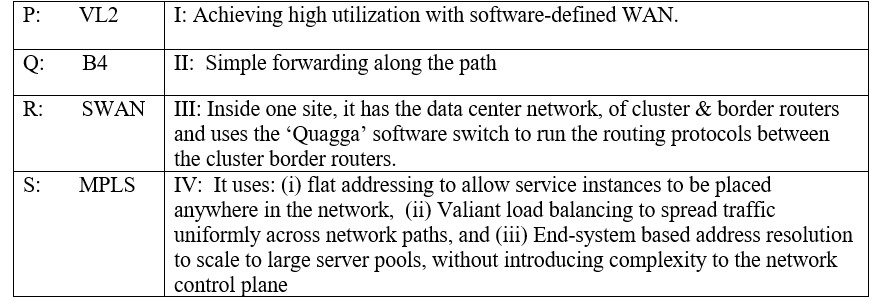This set of MCQ(multiple choice questions) focuses on the Cloud Computing and Distributed Systems NPTEL 2022 Week 2 Solutions.
Cloud computing is the on-demand delivery of computations, storage, applications, and other IT resources through a cloud services platform over the internet with pay-as-you-go business model. Today’s Cloud computing systems are built using fundamental principles and models of distributed systems. This course provides an in-depth understanding of distributed computing “concepts”, distributed algorithms, and the techniques, that underlie today’s cloud computing technologies. The cloud computing and distributed systems concepts and models covered in course includes: virtualization, cloud storage: key-value/NoSQL stores, cloud networking,fault-tolerance cloud using PAXOS, peer-to-peer systems, classical distributed algorithms such as leader election, time, ordering in distributed systems, distributed mutual exclusion, distributed algorithms for failures and recovery approaches, emerging areas of big data and many more. And while discussing the concepts and techniques, we will also look at aspects of industry systems such as Apache Spark, Google’s Chubby, Apache Zookeeper, HBase, MapReduce, Apache Cassandra, Google’s B4, Microsoft’s Swan and many others. Upon completing this course, students will have intimate knowledge about the internals of cloud computing and how the distributed systems concepts work inside clouds.
Course layout
Answers COMING SOON! Kindly Wait!
Week 1: Assignment answers
Week 2: Assignment answers
Week 3: Assignment answers
Week 4: Assignment answers
Week 5: Assignment answers
Week 6: Assignment answers
Week 7: Assignment answers
Week 8: Assignment answers
Week 9: Assignment answers
Week 10: Assignment answers
Week 11: Assignment answers
Week 12: Assignment answers
NOTE: You can check your answer immediately by clicking show answer button. Cloud Computing and Distributed Systems NPTEL 2023 Week 2 Assignment Solution” contains 10 questions.
Now, start attempting the quiz.
Cloud Computing and Distributed Systems NPTEL Week 2 Solutions
Q1. What are the two key design goals for Open vSwitch ?
a) Scalability and partitioning
b) Isolation and tunneling
c) Reliability and filtering
d) Flexible and fast-forwarding
Answer: d
Q2. Consider the following statements related to Software-defined networking (SDN) technology:
Statement 1: SDN is an approach to network management that enables dynamic, programmatically efficient network configuration in order to improve network performance and monitoring making it more like cloud computing than traditional network management.
Statement 2: SDN attempts to centralize network intelligence in one network component by disassociating the forwarding process of network packets (data plane) from the routing process (control plane).
a) Only statement 1 is true
b) Only statement 2 is true
c) Both statements are false
d) Both statements are true
Answer: c
Q3. Match the correct pairs:

a) P: IV, Q: III, R: I, S: II
b) P: IV, Q: I, R: II, S: III
c) P: III, Q: I, R: II, S: IV
d) P: II, Q: IV, R: III, S: I
Answer: a
Q4. True or False ?
Docker is an open-source project that automates the deployment of applications inside software containers, by providing an additional layer of abstraction and automation of OS–level virtualization on Linux.
a) True
b) False
Answer: a
Q5. ______________ is a network emulator which creates a network of virtual hosts, switches, controllers, and links.
a) Docker
b) Mininet
c) Hypervisor
d) KVM
Answer: b
Q6. To offer hot-spot free performance for arbitrary traffic matrices, VL2 uses two related mechanisms:
a) Flows and out-of-order delivery
b) Clos network and EQMP
c) Agility and Load balancing
d) VLB and ECMP
Answer: d
Q7. The key challenges of a Multi-Tenant Data Center are:
I. Performance uniformity
II. Agility
III. Scalability
IV. Location independent addressing
a) I, II, III
b) I, II, IV
c) II, III, IV
d) I, III, IV
Answer: b
Q8. Consider the following statements:
Statement 1: In Single-root I/O Virtualization (SR-IOV), forwarding is no longer as flexible because it relies on a layer two switch that is built into the hardware of the NIC.
Statement 2: In Single-root I/O Virtualization (SR-IOV), the live VM migration becomes trickier, because the virtual machine is tied to physical resources of the machine.
a) Only statement 1 is true
b) Only statement 2 is true
c) Both statements are true
d) Both statements are false
Answer: c
Q9. ____________ is the original OpenFlow controller. It serves as a network control platform, that provides a high level programmatic interface for management and the development of network control applications. Its system-wide abstractions turn networking into a software problem.
a) Routing Control Platform
b) 4D architecture
c) Ethane
d) NOX
Answer: d
Q10. Choose the correct items for X, Y, and Z.
X architecture comprises a hierarchy of controllers. At the top level we have the Y, which is talking to an SDN gateway. The gateway can be thought of as a super controller that talks to the controller’s at all these different Z.
a) X: Global controller, Y: Google’s B4, Z: Data center sites
b) X: Google’s B4, Y: Data center sites, Z: Global controller
c) X: Google’s B4, Y: Global controller, Z: Data center sites
d) X: Data center sites, Y: Google’s B4, Z: Global controller
Answer: d
<< Previous- Cloud Computing and Distributed Systems Week 1 Assignment Solutions
>> Next- Cloud Computing and Distributed Systems Week 3 Assignment Solutions
DISCLAIMER: Use these answers only for the reference purpose. Quizermania doesn't claim these answers to be 100% correct. So, make sure you submit your assignments on the basis of your knowledge.For discussion about any question, join the below comment section. And get the solution of your query. Also, try to share your thoughts about the topics covered in this particular quiz.
Checkout for more NPTEL Courses: Click Here!
